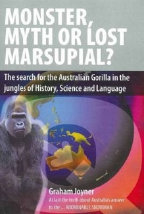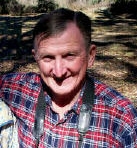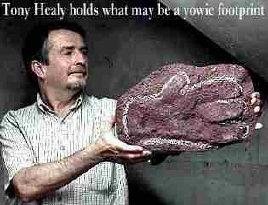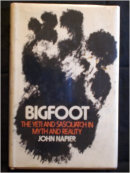
Contact

Home
The History of "Yowie Research"
Yowie / Bigfoot
The History of "Yowie Research"
Australian Yowie Research Centre Est...1976 Publicly by Rex Gilroy for the sole purpose of Scientific
Study of the Australian Hairy man
Australian Yowie Research Centre Est...1972 by Rex Gilroy at his Home for the sole purpose
of Scientific Study of the Australian Hairy man
Australian Yowie Research Centre First Est...in 1965 as an Idea by Rex Gilroy
for the Sole purpose of Scientific Study of the Australian Hairy man
"The Father of Yowie Research"
While the notion of scientifically studying the Yowie (the legendary man-beast of the Australian bush) at a specifically-built research centre sounds impressive, like many things "Yowie", the reality is somewhat different: Rex Gilroy is anything but scientific in his approach and outlook while his "research centre" is just the garage of his house. Not only are such distortions and falsehoods are commonplace among the practices of "The Father of Yowie Research" as well as those who have followed in Gilroy's footprints in recent years, they are essential components of the Yowie mythos.

Origin of the Yowie and Yowie Research
Graham Joyner (2009)
Monster, Myth or lost Marsupial? The Search for the Australian Gorilla in the Jungles of History, Science and
Language.

[T]he notorious yowie has become a familiar, even acceptable, part of contemporary Australian folklore or, if you prefer it, a predicable
element of Australian popular culture. A few years ago one could hardly pick up a newspaper or magazine without reading about it.
Portrayed as an enormous ape-like creature similar to the Himalayan yeti or the North American bigfoot, the yowie is also supposed
to have inhabited, and indeed still to inhabit, certain remote tracts of Australian bush where—so we are told—it has occasionally
been seen by European settlers over the last two centuries while having been known to the Aborigines for thousands of years. Yet the
truth is that ... the yowie was not known at all in the nineteenth century or for most of the twentieth century. In fact the popular
notion of the yowie first came to light less than four decades ago and its origins are associated as much with exotic as with indigenous
ideas. Indeed a great deal about the yowie is, as one might expect, not what it seems. Scientists have, with good reason, regarded
it with either amusement or disdain. (p2-3)
On May 5 1975 the Australian Broadcasting Commission (as the ABC then was)
presented on its radio program ‘A.M.’ an interview with Rex Gilroy, a field naturalist from Mt Victoria in the Blue Mountains to the
west of Sydney, about something called the yowie, supposedly Australia’s answer to the abominable snowman. Among other things, Gilroy
claimed that the yowie was an ape-like creature that had been known to the Aborigines and to white settlers from the earliest days
of colonisation, increasingly so in the last few years. Then, two days after the broadcast, the now defunct Sydney tabloid the Daily
Mirror took up the story under the heading ‘Yowie – It’s the Orange Monster!’. The report claimed that the creature had been sighted
near the city of Orange in central western New South Wales and added that the name ‘yowie’ was supposed to be an aboriginal word meaning
‘great hairy man’ (although this has never been confirmed and is almost certainly false). In later accounts Gilroy was to assert that
the yowie was an immense primate, some two and a half to three meters in height, which had probably reached Australia when the continent
was still connected by a land bridge to Asia. (As we have seen, it never was.) Most significantly, he claimed to have received nearly
3,000 reports from those who had experiences of the yowie. Gilroy later told Tony Healy that his information came not from newspaper
reports of the creature—which he thought were extremely rare—but from ‘the records of numerous cattle stations from last century,
and even for this century, which have recorded stories of sightings of these beasts’. He added that he had obtained all his information
on the subject ‘from country people and others who have either seen yowies or else preserved family stories from the last century’.
...


Rex Gilroy is an Australian who has written articles and self-published books on cryptids and unexplained or speculative phenomena. His work has focused on yowie reports, 'out of place' animals, UFOs, and propositions regarding a 'lost' Australian civilization.



28-02-2014
4 February 1973 - Those abominable snowmen
11 February 1973 - Letters to the Editor: Australia’s own abominable snowmen

An immediate problem is that the figure of 3,000 seems much too large—indeed a tenth of that number might be thought too many—but of course we have no way of knowing because although Gilroy has mentioned a great many cases he has never published the documents which he received. And, whatever the actual number, this failure to make available his data in its original form is a serious handicap to acceptance of his claims. Scientists normally want scientific hypotheses to be confirmed and tested in some way. Sporadic observations in the field represent difficulties of their own but when the only evidence is derived from documented reports of sightings there is a fundamental need for access to the records themselves. Only then could their contents be assessed, possibly by some comparative method...
The key point here is that the revelations about the yowie in May 1975, although then altogether new and unexpected, was not the first
time that Gilroy had made a claim of this kind. In fact there is a little-known precedent for the yowie which helps to explain its
later appearance, fully developed, in the public imagination. To understand what happened we need go back three years to the publication
in London in 1972 of a book by British anatomist John Napier entitled Bigfoot: The Yeti and Sasquatch in Myth and Reality. A review
of Napier’s book had appeared in the Sydney Sun-Herald on 4 February 1973. Then, a week later, on 11 February, the Sun-Herald published a letter from Gilroy in which he responded to the review with the startling suggestion that such a creature also existed in Australia.
But, surprisingly for those familiar with his later claims, this was not the yowie. Instead Gilroy wrote of a seven feet tall man-like
beast called Tjangara, allegedly known to the aborigines of the remoter regions in western and central Australia, and went on to link
this creature to huge stone artefacts supposedly found at sites near Bathurst and Brewarrina in central-western New South Wales. And
that was all—no mention of the yowie from eastern Australia as later defined, either by name or description.
(p5-7)
28-03-2014
The probable reason for this omission is that the notion of the yowie had not yet developed and it was the image of the yeti or the
bigfoot provided by Napier, together with responses from the public to Gilroy's letter of 11 February 1973, which shaped the as yet
embryonic idea of the yowie until the fully-fledged concept finally emerged in May 1975. (p7)
... all stories received by Gilroy
after May 1975 must be presumed to have been tainted by the massive publicity about the yowie... [and] it is almost certain that neither
the name 'yowie' in the sense of here discussed nor the image of the huge bigfoot-like creature (usually accompanied by plaster casts
of what are supposedly its enormous footprints, with imprints of toes so unlike those attributed to the yahoo) appears in Australia
before 1975. (p8)
Points of Interest
3000 Yowie Reports - When Rex Gilroy first wrote to the newspapers to proclaim that Australia already
had its version of the Abominable Snowman on the 11th of February 1973 (the Tjangara of central Australia - see here) there
were no Yowie reports from eastern Australia in his collection. Yet just 2 years later Gilroy claims to have received
some 3000 reported sightings of the Yowie. While the actual number of Yowie reports still remains unsubstantiated,
the alleged total seems largely to have remained the same - "I have over 3000 {great hairy man} Yowie reports, dating from
the earliest Aboriginal encounters, the First European encounters, right up to the present day 2006" [source]. It is likely that the
number of Yowie reports at any time is greatly exaggerated if not entirely fictional.
Gilroy's Own Yowie Sighting - Not only
is there no mention of the Yowie in Gilroy's 1973 letter to the editor, there is no mention of Gilroy's own Yowie sighting which
supposedly happened on the 7th of August 1970. Was this claim also just a work of fiction? Yowieocalypse will explore this issue at
a later time...
Origin of the Name 'Yowie'
Joyner (2009) continues:
Tony Healy and Paul Cropper, who have written extensively about the yowie, point to an isolated example of the name 'yowie' in a handwritten
account about Aborigines of the Bathurst district (between the Blue Mountains and Orange) by P. J. Gresser from the year 1964, but
this is clearly a different use of the word.
According to Gresser 'the Yahoo or Yowie' was a supernatural being recognized by
the Aborigines of much of the south-eastern Australia, including those of the Blue Mountains. On this evidence (almost the only evidence
available) the word 'yowie' is not an aboriginal word at all but merely a diminutive or variant of the English word 'yahoo', and probably
one used exclusively in the Blue Mountains and Bathurst regions... Almost certainly the word 'yowie' is not found elsewhere at this
time. The suggestion by the Australian National Dictionary that 'yowie' is derived from yuwi, a word from Yuwaalaraay language of
central northern New South Wales meaning 'dream spirit', does not come with any supporting evidence and appears to be merely an ill-advised
attempt to suggest an indigenous origin by finding some suitable Aboriginal word with a similar sound—in other words a wild guess.
But whatever its origin, it is clear the the word 'yowie' is used from 1975 onwards in a different sense from that which preceded
it, and it would be wrong to claim, on the basis of Gresser's reference, that the yahoo and yowie of 1975 onward are the same. In
summary, the revelations about the yowie in 1975 introduced both an entirely new concept and a new meaning for the word. And it seems
likely that this concept was largely a blend of two factors, namely images of the yeti or bigfoot from Napier's book and reports from
country people about the yahoo from the nineteenth century... (p8)
Mr. P. J. Gresser, who took a great interest in the aborigines of the Blue Mountains and Bathurst area, wrote in 1964 that the Mulgoa
and Burragorang people referred to the hairy giants as yowies. From at least the 1930s variations of the term, such as yowroo,
yowrie and yourie, were certainly used in that context by people in the Batemans Bay to Bega area.
Tony Healy and Paul Cropper,Out of the Shadows: Mystery Animals of Australia, Pan Macmillan Australia, Sydney 1994, p. 116.
Coming soon: Yowieocalypse to explore how the Yeti (or Abominable Snowman) of the Himalayas was portrayed in the Australian
media.

Early References to "Yowie"
To Do list:
- Rex Gilroy's alleged Yowie sighting (1970)
- an example of storytelling or of something
else?
- Tracking the Abominable Snowman in the Australian media
"From at least the 1930s variations of the term, such as yowroo, yowrie and yourie, were certainly used in that context by people
in the Batemans Bay to Bega area."
Note that Healy and Cropper provide no references to support this statement. It should also
be noted that 'Yowrie' first appears as a cattle station in the Twofold Bay district 40 km south Bega in
1845 and appears to have later become a small town which seems to have faded away by the late 1930s; while 'Yourie' similarly seems
to have been a property-cum-small town 20 km north-west of Bega which also seemed to have faded out in the 1940s. No references
to 'Yowroo' were found.
29-03-2014










